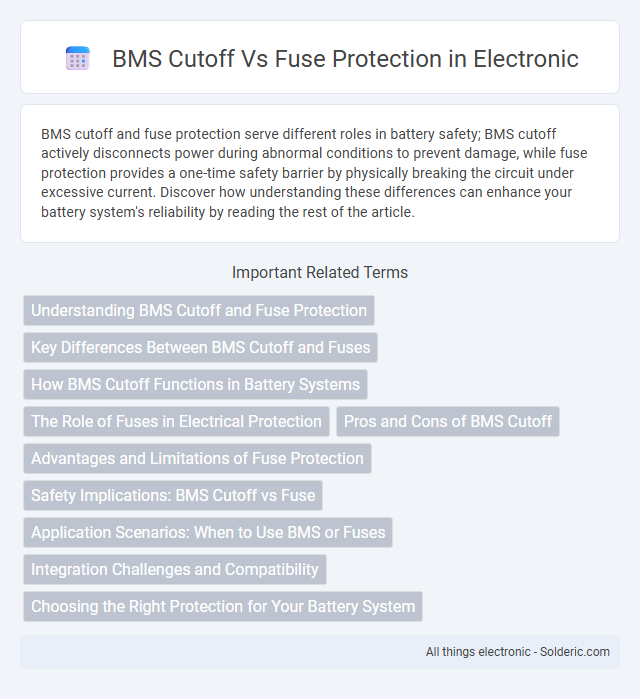BMS cutoff and fuse protection serve different roles in battery safety; BMS cutoff actively disconnects power during abnormal conditions to prevent damage, while fuse protection provides a one-time safety barrier by physically breaking the circuit under excessive current. Discover how understanding these differences can enhance your battery system's reliability by reading the rest of the article.
Comparison Table
| Aspect | BMS Cutoff | Fuse Protection |
|---|---|---|
| Function | Battery Management System disconnects circuit on fault detection | Physical device that breaks circuit on overcurrent |
| Protection Type | Voltage, current, temperature, and state monitoring | Overcurrent and short-circuit protection |
| Reusability | Reusable, automatically or manually resettable | Single-use; requires replacement after activation |
| Response Time | Fast, electronic-based cut-off | Depends on fuse rating; usually slower than BMS cutoff |
| Application | Battery packs, especially lithium-ion systems | General electrical circuits and battery protection |
| Complexity | Electronic system with sensors and control unit | Simple, passive component |
| Cost | Higher due to complexity and components | Lower, inexpensive element |
Understanding BMS Cutoff and Fuse Protection
BMS cutoff functions as an electronic safety mechanism that disconnects the battery pack to prevent overcharge, over-discharge, and short circuits by monitoring voltage, current, and temperature parameters. Fuse protection relies on a physical component designed to break the circuit by melting when excessive current flows, providing a one-time safeguard against short circuits or overloads. Understanding the distinct roles highlights that BMS cutoff offers dynamic, reusable protection with intelligent control, while fuses provide simple, passive, and irreversible overcurrent defense.
Key Differences Between BMS Cutoff and Fuses
BMS cutoff systems monitor battery parameters such as voltage, current, and temperature to intelligently disconnect power and prevent damage, ensuring precise protection and longer battery life. Fuses provide a one-time, non-resettable safety mechanism that physically breaks the circuit during excessive current flow, offering basic overcurrent protection without monitoring capabilities. Unlike fuses, BMS cutoffs enable smart, dynamic control and can reset automatically or alert users before critical failure occurs.
How BMS Cutoff Functions in Battery Systems
BMS cutoff functions by monitoring battery parameters such as voltage, current, and temperature to prevent hazardous conditions like overcharging, overdischarging, and overheating. When these parameters exceed safe thresholds, the BMS cutoff interrupts the electrical circuit, effectively halting battery operation to protect cells and extend battery lifespan. Unlike fuse protection, which relies on physical melting of a component during fault conditions, the BMS cutoff provides precise, real-time control and reset capability without component replacement.
The Role of Fuses in Electrical Protection
Fuses play a critical role in electrical protection by providing a reliable means to interrupt excessive current flow, safeguarding batteries and circuits from damage or fire hazards. Unlike BMS cutoff systems, which monitor and control voltage and temperature parameters to prevent battery malfunction, fuses respond instantly to overcurrent conditions by physically breaking the circuit. This rapid disconnection ensures that electrical faults do not escalate, complementing BMS functions for comprehensive battery safety.
Pros and Cons of BMS Cutoff
BMS cutoff systems provide precise battery management by monitoring voltage, current, and temperature to prevent overcharge, overdischarge, and short circuits, enhancing battery longevity and safety. However, BMS cutoffs can introduce complexity and cost to battery design and may fail if the system malfunctions or communication errors occur. Fuse protection offers simple, cost-effective overcurrent protection but lacks the intelligence and adaptability of a BMS cutoff to manage battery state and optimize performance.
Advantages and Limitations of Fuse Protection
Fuse protection offers a simple and cost-effective method to prevent overcurrent damage in battery management systems (BMS) by physically breaking the circuit when current exceeds a predefined threshold. Its advantages include instant response time and no need for additional power or complex electronics, making it highly reliable in fault conditions. However, fuse protection has limitations such as single-use operation requiring replacement after tripping, inability to provide precise current monitoring, and lack of adaptive control compared to BMS cutoff mechanisms.
Safety Implications: BMS Cutoff vs Fuse
BMS cutoff systems provide precise, real-time voltage and current monitoring to prevent overcharge, overdischarge, and short circuits, enhancing battery safety with automated, intelligent shutdowns. Fuses offer a one-time, passive protection by physically breaking the circuit under excessive current, but lack the ability to react to subtle or gradual battery failures. Your safety is significantly improved with a BMS cutoff, as it actively manages battery health, whereas fuses only protect against acute overloads without ongoing risk assessment.
Application Scenarios: When to Use BMS or Fuses
BMS cutoff systems are ideal for advanced lithium-ion battery packs in electric vehicles and energy storage, offering precise monitoring and balancing to prevent overcharge, overheating, and deep discharge. Fuse protection suits simpler setups or backup safety where cost and space constraints prioritize straightforward overcurrent interruption without smart controls. Use BMS cutoff when battery lifecycle optimization and real-time health data are critical, while fuses are preferred for basic overcurrent protection in less complex or disposable battery configurations.
Integration Challenges and Compatibility
BMS cutoff and fuse protection present integration challenges related to their differing response mechanisms and electrical characteristics, which can complicate seamless compatibility in battery safety systems. Ensuring synchronized operation requires meticulous calibration of the BMS control algorithms to accommodate the fixed, one-time operation nature of fuses, preventing nuisance trips or delayed disconnects. Compatibility issues arise when fuse ratings do not align with the BMS cutoff thresholds, necessitating comprehensive system-level design optimization for effective overcurrent protection.
Choosing the Right Protection for Your Battery System
Choosing the right protection for your battery system involves comparing BMS cutoff and fuse protection based on safety and reliability. BMS cutoff offers intelligent monitoring of voltage, current, and temperature, automatically disconnecting the battery during abnormal conditions to prevent damage. Fuse protection provides a simple, cost-effective fail-safe by physically breaking the circuit during overloads or short circuits but lacks real-time diagnostics and control capabilities.
BMS cutoff vs fuse protection Infographic

 solderic.com
solderic.com